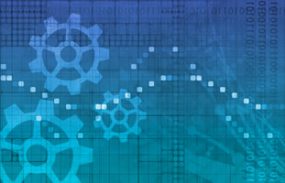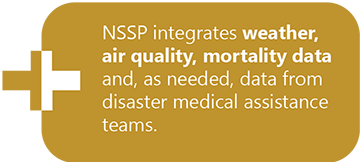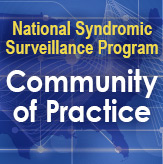Technical Updates

NSSP Software Release
Twice a year, in spring and fall, NSSP schedules major software releases that address features and capabilities recommended by the community, improve system performance, and take advantage of new technologies. The fall release took place in September 2022.
Access & Management Center (AMC) High-level Updates
- Improved Ability to Manage Users—Site administrators can use this alternate, simplified workflow to add users and user groups to data access rules. The additions can be done directly from the Add/Edit User form.
- Improved User Group Report Feature—Site administrators can download user group data to improve their awareness of current data sharing activities and easily track information.
- Improved Master Facility Table (MFT)
- The MFT will display City, State, and ZIP code for Associated Facilities, which site administrators can view on the MFT’s Edit Primary Facility form.
- Site administrators can edit information for Associated Facilities from the Primary Facility Information page.
- Operational Crosswalk Added to MFT—Site administrators can view Operational Crosswalk information on the MFT form for a primary facility.
Data Quality Dashboard
(found in AMC under Edit Primary Facility)
- Top Menu Improvements—Users can change user type and/or connection.
- Expandable/Collapsible Grid Cards—These cards house all data-driven elements of the previous dashboard. Most notably, the data visuals and data tables are in the new grid card format.
- Selected Filters Component Added—This feature is the driving force behind the new Data Quality Dashboard. Users may add or remove data elements to/from the filter to view the desired data.
- New DQ Visuals—Dynamically updated plotting based on user-defined data elements is available and can be modified via the new Selected Filters component.
- Improved Alerts—View logged alerts, comment on, and view history of existing alerts.
- Customized Alerts—Via the Alerts Settings, users may choose from four major data categories (data flow, completeness, validity, and timeliness) and tune their settings to receive alerts that fit specific criteria.
Data Modernization Initiative: How DMI Applies to NSSP
At the July 27, 2022, meeting of the National Syndromic Surveillance Program (NSSP) Community of Practice (CoP), Acting Program Lead Karl Soetebier described how the Data Modernization Initiative (DMI) will affect improvements to NSSP.
For starters, the NSSP strategic plan, which includes activities that fall under the DMI umbrella, calls for strengthening the infrastructure. NSSP architects are improving the current platform cloud architecture and implementing alternative cloud architecture. Developers are modernizing the ESSENCE user interface, and the onboarding team is working on a multifaceted approach to increase the number of participating facilities and fill gaps in emergency department data. NSSP analysts are working to improve the quality of data monitoring tools and to complete the integration of mortality data, while also working on new data sources (e.g., data from National Notifiable Diseases Surveillance System, COVID-19 electronic laboratory reporting data).
This fast-paced, detailed overview gives insight into NSSP’s goals for the next 2 to 3 years. You can access the recordings directly or from the NSSP CoP Knowledge Repository (click Meeting Recordings > NSSP CoP Monthly Call).


Daily NSSP-processed Messages:
◾ 400,000 from U.S. Department of Defense
◾ 100,000 from U.S. Department of Veteran Affairs
◾ 1,100,000 from Commercial Laboratory (2 Labs)
Now Available! Ultimate Guide for Site Administrators
Ever have a moment when you want one—just ONE—go-to resource for navigating NSSP’s approach to syndromic surveillance? If you’re a site administrator, or new to NSSP, how do you get started? Resources abound, but what’s important—or isn’t?
Got ya covered. After consulting our team of onboarding experts who point NSSP entrants to surveillance resources almost daily, we’ve developed what we’re calling the Ultimate Guide for Site Administrators. It groups complementary information and links to “best of” guidance posted on the NSSP website, Knowledge Repository, and partner websites.
The Ultimate Guide for Site Administrators is an essential resource for site admins. Even if you’re not a site admin but have recently joined NSSP, you’ll find the guide useful. It highlights the community’s best practices. It suggests ways to connect with peers and exchange technical solutions quickly and points to all things NSSP. It’ll jump start your learning about NSSP–ESSENCE.
Publication Updates
- The new BioSense Platform User Manual for the Access & Management Center has been updated with changes made through release 1.6.3, such as new non-site administrator permission levels allowing view and edit access to the Master Facility Table, plus a new feature to add or edit multiple facilities using batch upload, additional reminders in the Manage Users and User Group interfaces, and new last editor and time limit columns added to the data access rules table. The manual is available now in the NSSP Technical Resource Center on the Technical Publications and Standards
- The Quick Start Guide to Using the Access & Management Center Data Access Rules was published in July (see NSSP Technical Resource Center Technical Publications and Standards webpage). This refresh adds information on the features available in AMC version 1.6.3. New features such as Access Limits and Timeframe options are documented, as well as last editor and time limit columns have been added to the data access rules table.
- An updated Quick Start Guide to Using the Master Facility Table (MFT) has been posted in the NSSP Technical Resource Center on the Technical Publications and Standards This detailed guide to the MFT user interface provides new information on bulk edits and upload features, changes to the primary facility input forms, as well as new fields added.
- The BioSense Platform User Manual for RStudio Workbench, which replaces the Quick Start Guide to Using RStudio Pro, has been posted in the Technical Publications and Standards The manual explains new features, licensing requirements, and use of the Rnssp package for user validation. Screenshots and other images have been updated.
- An article has been added to the Onboarding webpage: “When to Use Associated Facilities: Guidance for Site Administrators.” Authored by the NSSP onboarding team, the article explains how associated facilities can function as a single entity so that ESSENCE can display data in a time-series graph.
- The Guide to Developing Queries is in development and scheduled for September posting in the NSSP Technical Resource Center. The NSSP onboarding team is developing this guide to consolidate the most valuable tips and resource materials for developing syndrome definitions and queries.
- The Ultimate Guide for Site Administrators groups related links and resources from the CDC/NSSP and NSSP CoP websites in one location. The guide, developed by NSSP’s onboarding team, is based on discussion topics and questions asked during onboarding training. It will be valuable to anyone new to NSSP tools, resources, and processes.
